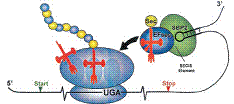Biochemistry, Department of

Vadim Gladyshev Publications
Document Type
Article
Date of this Version
2-27-2009
Abstract
Protein oxidation has been linked to accelerated aging and is a contributing factor to many diseases. Methionine residues are particularly susceptible to oxidation, but the resulting mixture of methionine R-sulfoxide (Met-RO) and methionine S-sulfoxide (Met-SO) can be repaired by thioredoxin-dependent enzymes MsrB and MsrA, respectively. Here, we describe a knock-out mouse deficient in selenoprotein MsrB1, the main mammalian MsrB located in the cytosol and nucleus. In these mice, in addition to the deletion of 14-kDa MsrB1, a 5-kDa selenoprotein form was specifically removed. Further studies revealed that the 5-kDa protein occurred in both mouse tissues and humanHEK293 cells; was down-regulated by MsrB1 small interfering RNA, selenium deficiency, and selenocysteine tRNA mutations; and was immunoprecipitated and recognized by MsrB1 antibodies. Specific labeling with 75Se and mass spectrometry analyses revealed that the 5-kDa selenoprotein corresponded to the C-terminal sequence of MsrB1. The MsrB1 knock-out mice lacked both 5- and 14-kDa MsrB1 forms and showed reduced MsrB activity, with the strongest effect seen in liver and kidney. In addition, MsrA activity was decreased by MsrB1 deficiency. Liver and kidney of the MsrB1 knock-out micealsoshowedincreasedlevelsofmalondialdehyde,proteincarbonyls, protein methionine sulfoxide, and oxidized glutathione as well as reduced levels of free and protein thiols, whereas these parameters were little changed in other organs examined. Overall, this study established an important contribution of MsrB1 to the redoxcontrolinmouseliverandkidneyandidentifiedanovelform of this protein.


Comments
Published in THE JOURNAL OF BIOLOGICAL CHEMISTRY VOL. 284, NO. 9, pp. 5986–5993, February 27, 2009.